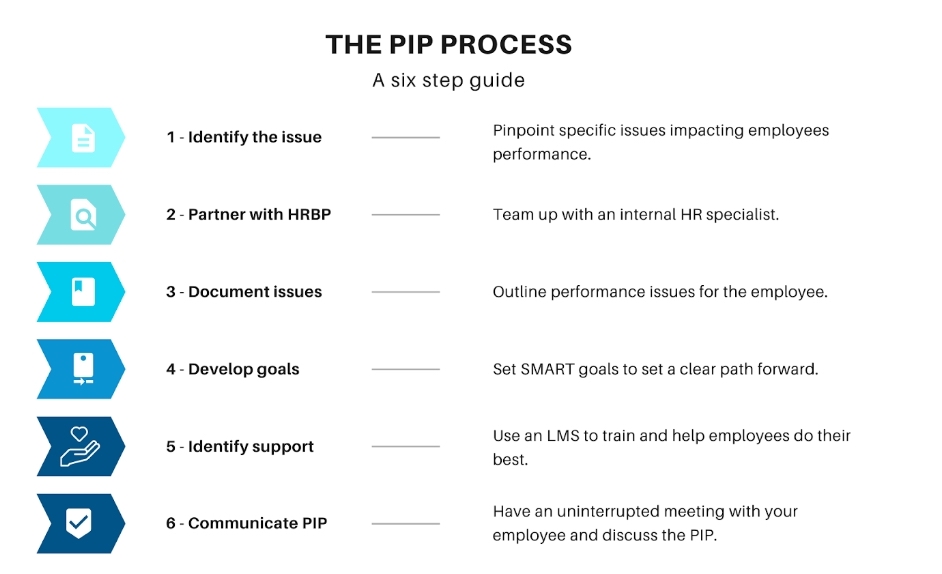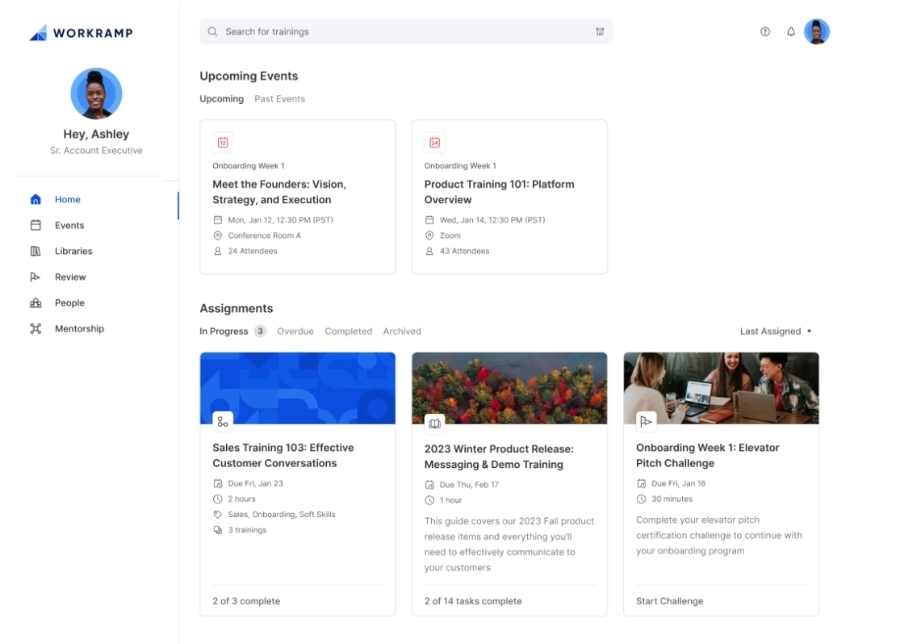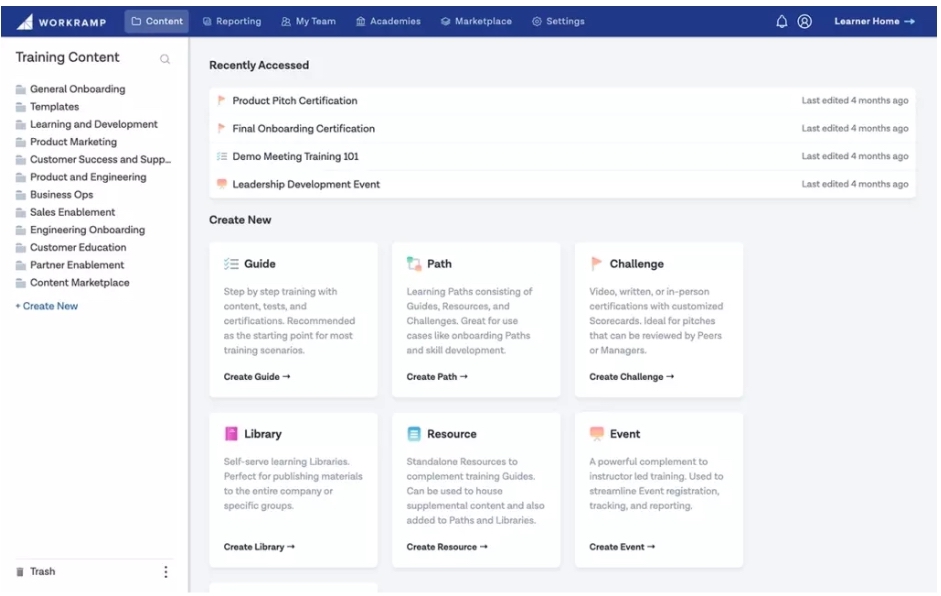From PIP to Top Performer: How to Motivate & Empower Underperforming Employees
Michael Keenan | WorkRamp Contributor
View bioLearning Tips Straight to Your Inbox
Performance issues are an all-too-common struggle. Even the most successful teams experience underperforming employees. As a manager, these issues can be hard to address and leave many feeling stuck.
You owe it to your team to strengthen morale and get everyone back on track.
An effective way to address performance issues is a Performance Improvement Plan (PIP). We spoke with Casey Keenan, Compass’s Senior Learning & Development Manager, about managing a PIP and helping employees improve performance.
Casey runs a learning and development (L&D) program for over 1,500 employees and partners and walks us through his PIP process with tips he’s learned over the years.
In this post:
Purpose of a Performance Improvement Plan (PIP)
Manage them up
Casey explains that PIPs are for when employees are having performance issues. It’s when “you’ve gone through the process of a verbal and written warning. You’ve discussed the areas they are not performing and how they are not meeting the needs of your role. You’ve tried to help them in the standard ways.”
PIPs generally last 30, 60, or 90 days, depending on how long it takes to improve the specific issue.
The PIP:
- Outlines the performance issues
- Sets clear expectations for improvement
- Provides a time frame for meeting those expectations
“So now that a written plan is in place, we can set goals and milestones for this person to achieve.” That’s what Casey refers to as ‘managing them up.’ The employee is aware it’s their last chance to prove themselves and meet the expectations of their role.
Manage them out
If, despite the PIP, the employee still doesn’t meet the expectations, you might consider managing them out. This means parting ways with the employee for the benefit of both parties.
“As managers, we need to understand that there is a point where sometimes it’s best for you, the business, and the employee to manage them out,” Casey adds. In this case, a PIP serves as a formal document showing the company’s effort to improve the employee’s performance before terminating employment.
This is always done professionally and respectfully and complies with local employment laws and company policies.
Common reasons to put employees on a PIP
A Performance Improvement Plan (PIP) can be put in place for various reasons:
Poor job performance
This is the most common reason. If an employee’s work is consistently below expectations, you might place them on a PIP.
This includes missing targets, producing low-quality work, or making too many mistakes.
Failure to meet deadlines
Employees who consistently fail to complete their assignments on time can get put on a PIP. Their actions can disrupt team projects and organizational plans.
Attitude problems
It’s bad for the working environment when people have negative attitudes.
If employees are consistently negative, uncooperative, or resistant to feedback, you could place them on a PIP to address these behaviors.
Attendance issues
Consistently being late or absent without a valid reason could result in being placed on a PIP.
“Remember that a PIP is a tool for improvement, not punishment. The goal is to clearly communicate these issues to an employee and give them the support they need to meet expectations,” Casey explains.
A PIP is the last step, he describes. For example, suppose the role is responsible for ensuring vendors are up to date on process improvements and change management, and that’s not happening, even after verbal and written warnings. In that case, you place them on a PIP.
How to create an effective PIP

Turning your employee into a top performer starts with creating a clear PIP.
Let’s go step by step through the process.
1. Identify the issue
First, establish the standard or expected level of performance for the role in question.
These should be clearly defined, measurable criteria that are aligned with the employee’s job description and the organization’s goals.
Then, pinpoint the specific issues impacting an employee’s performance. Maybe they are consistently missing sales targets or receiving negative feedback on their communication and teamwork skills.
2. Partner with an HR Business Partner (HRBP)
Say you’re managing a software company, and your employee, John, keeps missing his deadlines. Despite your efforts to provide assistance, John’s performance hasn’t improved and is hurting team productivity.
The first thing you want to do is partner with an HRBP or whoever is an expert in employment in your organization. An HRBP will guide you through the legal and procedural requirements to ensure a compliant and fair process.
“Together, you would review John’s performance, including instances of missed deadlines, team impact, and previous discussions you’ve had about his performance,” Casey says. “The HRBP will help you accurately record everything and ensure you have a clear case for putting John on a PIP.”
An HRBP can also help you:
- Create the PIP document itself
- Communicate effectively with the employee
- Handle any potential reactions
“By partnering with the HRBP from the beginning, you ensure the PIP process is handled professionally and fairly,” Casey adds. “It also provides John with the best possible chance of improvement and protects the company from potential legal repercussions.”
3. Document the performance issues
Create a detailed document outlining the performance issues.
Be specific and use objective evidence wherever possible. This includes data on missed deadlines, feedback from colleagues, or examples of substandard work. You’ll form the basis of your PIP with this information.
4. Develop improvement goals
Setting goals is the most important step in creating a PIP. They provide a clear path forward for the employee. It also defines what they need to do to improve performance.
Casey recommends setting SMART goals:
- Specific
- Measurable
- Actionable
- Relevant
- Time-bound
Let’s look at an example. Say your employee is a Customer Service Representative who has been receiving poor customer feedback. You are putting them on a PIP and choose to set the following SMART goal:
- Specific: Improve problem-solving skills to increase customer satisfaction and decrease the number of repeat calls for the same issues
- Measurable: Decrease repeat customer calls about the same issue by 30% and increase customer satisfaction scores from 75% to 85% on post-call surveys
- Achievable: The representative will complete an advanced problem-solving training course and engage in weekly coaching sessions with their supervisor
- Relevant: Enhanced problem-solving skills are vital in customer service to improve customer satisfaction, loyalty, and overall brand reputation. It aligns with the company’s objective of providing superior customer service
- Time-bound: The representative should achieve this goal within the next 90 days, during which they will handle numerous customer queries
When asked about a good time frame, “It depends on the role. A good time frame is often between 1 to 3 months. This is a good amount of time for employees to show improvement based on your plan. It also gives them a sense of urgency and makes it easier to track their progress,” Casey says.
5. Identify support and resources
Next, figure out what resources this person needs to achieve their goals. Support can come as additional training, mentoring, software, or access to specific resources. It may even involve you reallocating certain tasks or adjusting the employee’s workload.
“As a manager, you must choose the best support for your employee. Start by understanding the root cause of these performance issues. Then, consider the best resources available to help,” Casey explains.
A Learning Management System (LMS) is helpful here. It allows you to assign specific training courses to employees based on their needs. You can also give them access to curated tools or content to support them through the process.

An LMS like the Learning Cloud makes it easy to track learner progress. You can review employee performance and make any necessary adjustments.
6. Communicate the PIP
The last step is to communicate your PIP. Before you schedule the meeting, go back and get final approval from your HRBP. Again, you have to keep it compliant here.
Once that’s squared away, you’re ready to meet with the employee. “I can’t stress the importance of getting this meeting right,” Casey explains. “You have to genuinely show the employee that you want the best for them and that what you’re doing is trying to help them. If they feel otherwise, they will never take the PIP seriously and will eventually leave.”
Casey recommends the following for your meeting:
- Have clear and concise communication: In the meeting, clearly communicate the purpose of the PIP, the issues that led to it, and the goals for improvement. Keep constructive and focused on the future rather than overly focused on past mistakes.
- Present the PIP document: Present the PIP to the employee during this meeting. It’ll contain specific details about the performance issues, improvement goals, timeline, and the support and resources that will be provided.
- Maintain open discussion: Encourage an open dialogue. Let the employee voice their thoughts, feelings, and any concerns they may have. They might have useful insights into the performance issues and suggestions for the improvement plan.
- Explain the consequences: Be transparent about what will happen if they don’t meet the performance goals outlined in your PIP.
- Reiterate your support: Emphasize that the PIP is for the employee’s improvement and success. Make sure the employee knows he or she is not alone in this process and that you, as a manager, are there to support them.
Tips for turning your PIP into a high performer
An effective PIP is the first step to getting employees back on track.
Whether it’s your first or fifth PIP, remember the following tips.
Create a culture of learning in your organization
A learning culture is a work environment where continuous learning is a priority. And according to Casey, it plays a huge role in the success of your PIP.
“Your company must be built around developing a safe space for failure. Employees need to know that they won’t be disciplined if they mess up. Instead, they can turn their failures into development opportunities,” he says.
Read more: How to Create a Learning Culture
Turn the PIP into a learning experience
The PIP process is a learning experience for everyone.
For the employee, a PIP is a chance to understand the expectations of their role and know what they need to be successful. It also allows them to accept feedback (which is hard for many people to do) and implement it successfully.
“PIPs are a great learning experience for managers, too. Maybe you uncovered something new about your management style. For example, you weren’t setting clear enough expectations for employees,” Casey explains.
“It’s also an excellent way to flex your manager muscles when they count. You can’t become a good manager unless you’ve gone through hard experiences like a PIP. Whether the employee is successful or not, you become a better manager for it.”
Read more: Leaders: Don’t Make These 9 Mistakes When Giving Feedback
Discuss the impact
When employees understand how their performance affects the team, it creates a sense of responsibility.
Sometimes, an underperforming employee may not know what’s expected of them or how their actions impact the company. Understanding this can motivate them to improve.
Be crystal clear on expectations from the start
Set clear expectations from the start of what success looks like in each role. “In your 30, 60, 90, after you first hire someone, managers must give employees a clear pathway to meet expectations.”
If an employee is hired to manage social media, give them the specifics—how many posts per week, which platforms, and what kind of content. This clarity eliminates confusion and enhances performance.
Set smaller goals
The timeframe for your PIP will be around 1 to 3 months. That’s a big objective that you can break down into smaller, more achievable tasks.
Casey recommends setting weekly goals for your employee that help them meet the greater SMART goals you set.
Meet with employees multiple times a week
Meet weekly to guarantee employees are achieving the goals you set for them.
Break out your week into three meetings:
- 15-minute meeting on Monday: to check-in on tasks for the upcoming week
- 30-minute meeting on Wednesday: to offer help for any weekly tasks
- 15-minute chat on Friday: to discuss progress and align for next week’s goals
If someone is struggling with a task, frequent check-ins let you offer help sooner than later. It’s like a coach giving feedback to an athlete during the game, not just after. It helps correct course and improves performance in real time.
Read more: How to Create a Coaching Culture to Support Employee Development
Reward improvements in performance
Recognize employees’ good work with Slack acknowledgment, shoutouts during All-Hands meetings, trust and ownership, or a Team Member of the Month award.
Use an LMS to train employees
An LMS tailors training to the employee’s specific needs, focusing on areas where they need to improve, much like a personalized study plan.
If you’re using WorkRamp, you can create customized learning paths based on your PIP.

WorkRamp also includes tracking features. You can use them to monitor course progress, and assessment scores and see how much time is spent on training. The employee can also engage with other learners and access a library of on-demand resources.
Final thoughts
Putting an employee on a PIP can feel like a necessary evil. You know it’s necessary, but it’s not always obvious how to run a PIP process that checks all the right boxes. After spending your time and energy creating a PIP, the follow-up can seem like a chore.
But that’s the most critical time. Create a culture of learning, show up for your employees, and train them with an LMS. Do that, and you’ll be well on your way to taking your employee from PIP into a top performer.
Empower your employees to meet their full potential. Discover how the Learning Cloud can help you create effective employee training programs. Contact us to schedule a free, personalized demo.
Complete the form for a custom demo.
Recent Posts
- WorkRamp Launches AI Practice to Revolutionize Sales Enablement July 22, 2024
- How to Recognize Employee Burnout July 17, 2024
- What is the Best SCORM-compliant LMS? July 10, 2024
- How to Make a Training Module For Online Learning (2024 Guide) July 1, 2024
- The Role of Emotional Intelligence in Sales Enablement June 28, 2024
Michael Keenan
WorkRamp ContributorMichael is a SaaS marketer living in Guadalajara, Mexico. Through storytelling and data-driven content, his focus is providing valuable insight and advice on issues that prospects and customers care most about. He’s inspired by learning people’s stories, climbing mountains, and traveling with his partner and Xoloitzcuintles.
You might also like
What are the benefits of online learning?
When it comes to professional development and continued learning, online courses and programs offer several advantages over traditional in-person options.
Read More
Create engaging eLearning content for your teams
eLearning gives organizations the flexibility that other online courses can offer, but creating courses that are engaging and impactful can be harder than you think.
Read More
Find the best LMS to empower employees, customers, and partners
Learning management systems, or LMSs, are an indispensable tool for increasing team productivity and effectiveness. But with multiple platforms, the key lies in choosing the right one, as not all LMS are created equal.
Read More
Decrease Ramp Time and Increase Revenue
Get in touch to learn how WorkRamp can help you achieve your learning and development goals.
Request a Demo



